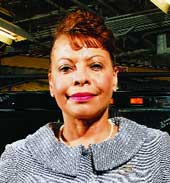No. 1: Lockheed Martin's reinvention

Company combines IT, services and support into one unit.
When Linda Gooden looks at the federal market, she asks this basic question: How do we provide the highest level of service to the citizen?That service can take many forms for Lockheed Martin Corp., which comes in at No. 1 on the Top 100 with $12.7 billion in prime government services revenue.For Gooden, information is the heart of the answer to her question, whether providing data to warfighters in combat zones or helping deliver Social Security benefits."When we talk about supporting the customer's mission, we're talking about interoperability and information sharing," she said.Those concepts were driving forces behind Lockheed's creation of the Information Systems and Global Services business area in February. Gooden leads the new division as executive vice president. It combines the Integrated Systems and Solutions business area with the Information Technology and Global Services area, which Gooden ran for several years. The two areas accounted for about $9 billion of Lockheed's overall revenue of $39.6 billion in 2006.The combination was at least five years in the making, Gooden said, as the two areas worked together on projects, such as the $1.9 billion contract Lockheed won in February 2005 to build and operate the Federal Aviation Administration's automated flight service station network.The two business areas also worked together to win the Air and Space Operations Center Weapons Systems Integrator contract. The first task order under that contract is worth $600 million.Another example is the $315 million FBI Sentinel contract, under which Lockheed and its team are developing a system for the processing, storage and management of the FBI's criminal investigation records. The company won the contract in March 2006.The contracts are examples of how Lockheed can combine its capabilities to deliver a more complete solution to its customers, Gooden said. In the case of FAA, for example, the company pulled together software developers to build the system, IT infrastructure experts to build the network, the company's process outsourcing group to do business process re-engineering and the company's services group to provide the employees to run the call centers."We put all of those things together and provided an offering to the customer that was very comprehensive and efficient," she said.That approach is the future of the government market, Gooden said. She estimated that about 40 percent of her unit's work involves combining various technologies, skills, business offerings and capabilities into a single, enterprisewide offering."Over the last 25 years, we've gone through the automation phase, then the integration phase." she said. "Now we are very much in the aggregation phase. When we talk about aggregation, one of the most important things is understanding the customers' domain."The need for interoperable systems and information sharing creates demand for these aggregated solutions, Gooden said."Prior to Sept. 11, [2001], we wouldn't think in terms of interoperability and information sharing," she said. "Many of our customer communities were in a very strict need-to-know environment. Now it is a need-to-share but with the appropriate security mechanisms."With this approach, Lockheed is positioning itself for growth in areas such as health care, humanitarian relief support, identity management, geospatial systems and situational awareness.Acquisitions in the past year have brought technical expertise and customer relationships in those areas. For example, Lockheed acquired Pacific Architects and Engineers Inc. to bolster its presence in the State Department, where the 6,000-person company supported peacekeeping and nation-building missions. This work also helps shield Lockheed from the ups and downs of the budget cycle.Another key acquisition was Savi Technology Inc., a maker of radio frequency identification technologies. Lockheed is developing an in-transit visibility network that lets users track cargo in real time with RFID tags.Lockheed has always been able to pull capabilities from across the company to build solutions for customers, but with the creation of the Information Systems and Global Services business area, developing innovative solutions will be easier and more efficient, Gooden said.

Profiles of the Top 20 companies in the 2007 Top 100
No. 1: Lockheed Martin's reinvention
No. 2: With SBInet, Boeing IDS takes flight
No. 3: Northrop Grumman rises to new challenges
No. 4: KBR gets down to business
No. 5: IPO catapults SAIC into a new era
No. 6: Raytheon strives for balance
No. 7: General Dynamics in full sprint
No. 8: Fluor's ready in a pinch
No. 9: L-3 leadership stays the course
No. 10 EDS, Hard-learned lesson
No. 11 CSC, Experience that counts
No. 12: Battelle seeks new frontiers
No. 13: Booz Allen, Quality over quantity
No. 14: Bechtel telecom makes a splash
No. 15: For BAE, persistence pays off
No. 16: ITT makes a push into new markets
No. 17: Dell, Talking about evolution
No. 18: Technology and service fuel IBM
No. 19: Verizon caps off a busy year with a big win
No. 20: United Technologies gains altitude

"When we talk about supporting the customer, we're talking about interoperability and information sharing." Linda Gooden
Rick Steele
Profiles of the Top 20 companies in the 2007 Top 100
No. 1: Lockheed Martin's reinvention
No. 2: With SBInet, Boeing IDS takes flight
No. 3: Northrop Grumman rises to new challenges
No. 4: KBR gets down to business
No. 5: IPO catapults SAIC into a new era
No. 6: Raytheon strives for balance
No. 7: General Dynamics in full sprint
No. 8: Fluor's ready in a pinch
No. 9: L-3 leadership stays the course
No. 10 EDS, Hard-learned lesson
No. 11 CSC, Experience that counts
No. 12: Battelle seeks new frontiers
No. 13: Booz Allen, Quality over quantity
No. 14: Bechtel telecom makes a splash
No. 15: For BAE, persistence pays off
No. 16: ITT makes a push into new markets
No. 17: Dell, Talking about evolution
No. 18: Technology and service fuel IBM
No. 19: Verizon caps off a busy year with a big win
No. 20: United Technologies gains altitude
NEXT STORY: When science is the answer


